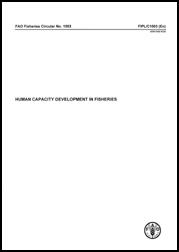|
Macfadyen, G.; Huntington, T.
Human capacity development in
fisheries.
FAO Fisheries Circular. No. 1003. Rome, FAO. 2004.
80p.
ABSTRACT
Human capacity development in fisheries is increasingly
recognized as a high priority, especially as regards to meeting the targets set
by the World Summit on Sustainable Development in the areas of global reporting
and assessment of the state of the environment by 2004, implementing recent
International Plans of Action (e.g. on fishing capacity by 2005, and on Illegal,
Unreported and Unregulated (IUU) Fishing by 2004), applying the ecosystem
approach by 2012 and maintaining or restoring fish stocks by 2015. A special
focus on human capacity development is particularly important now, partly
because of new approaches to fisheries management and also because of changes in
the international development context driven by the failure of many previous
development initiatives and the realization of the key role that capacity
development must play in supporting sustainable development.
This discussion paper first presents conceptual ideas on
capacity development, then examines capacity development needs in fisheries,
past approaches to capacity development (both in fisheries and other sectors)
and key lessons that can be drawn from them. A review of current approaches
assesses ongoing initiatives, leading to a discussion on the wide range of
possible delivery mechanisms. Finally, a strategy for human capacity development
in fisheries is introduced, along with related actions and models followed by
some key recommendations on research topics. |
